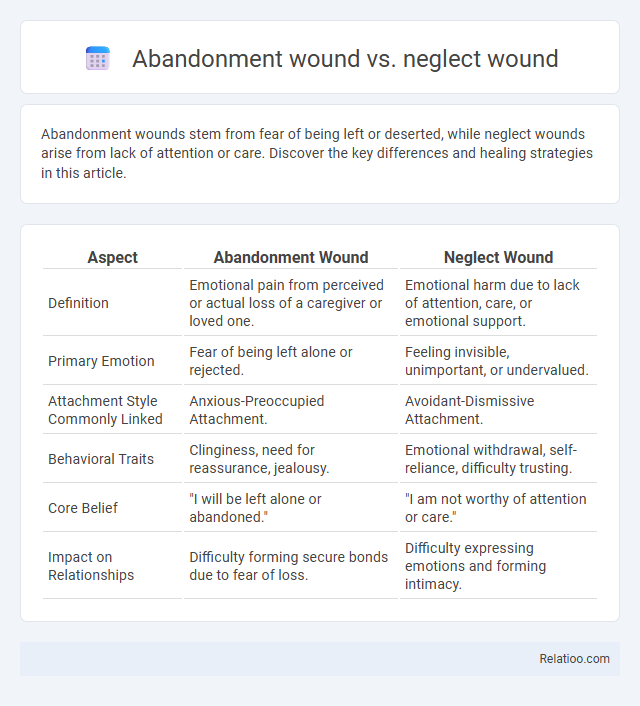Abandonment wounds stem from fear of being left or deserted, while neglect wounds arise from lack of attention or care. Discover the key differences and healing strategies in this article.
Table of Comparison
| Aspect | Abandonment Wound | Neglect Wound |
|---|---|---|
| Definition | Emotional pain from perceived or actual loss of a caregiver or loved one. | Emotional harm due to lack of attention, care, or emotional support. |
| Primary Emotion | Fear of being left alone or rejected. | Feeling invisible, unimportant, or undervalued. |
| Attachment Style Commonly Linked | Anxious-Preoccupied Attachment. | Avoidant-Dismissive Attachment. |
| Behavioral Traits | Clinginess, need for reassurance, jealousy. | Emotional withdrawal, self-reliance, difficulty trusting. |
| Core Belief | "I will be left alone or abandoned." | "I am not worthy of attention or care." |
| Impact on Relationships | Difficulty forming secure bonds due to fear of loss. | Difficulty expressing emotions and forming intimacy. |
Understanding Abandonment and Neglect Wounds
Abandonment wounds stem from the traumatic experience of feeling deserted or unloved, often leading to deep emotional scars characterized by insecurity and fear of rejection. Neglect wounds arise from chronic lack of care or attention during critical developmental periods, resulting in feelings of unworthiness and difficulty trusting others. Understanding the distinction between abandonment and neglect wounds is crucial for effective therapeutic approaches, as abandonment centers on loss and separation, while neglect involves persistent deprivation of emotional or physical needs.
Defining the Abandonment Wound
The abandonment wound refers to the deep emotional pain and insecurity experienced when a person perceives loss or rejection from a primary caregiver or significant other, often leading to feelings of unworthiness and fear of being left alone. Unlike neglect wounds, which arise from a lack of attention or care, and physical wounds, the abandonment wound is primarily psychological and affects attachment styles and interpersonal relationships. This wound can manifest in behaviors such as clinginess, distrust, or avoidance, significantly impacting emotional health and relationship dynamics.
What is a Neglect Wound?
A neglect wound is a type of injury that results from prolonged lack of care or attention to a physical condition, often leading to tissue damage and infection. Unlike an abandonment wound, which stems from emotional or psychological trauma due to being forsaken, a neglect wound primarily concerns physical health deterioration caused by insufficient medical treatment or hygiene. Understanding your neglect wound involves recognizing the signs of untreated conditions and seeking timely medical intervention to prevent further complications.
Core Differences: Abandonment vs Neglect
Abandonment wounds arise from emotional trauma due to feelings of being left behind or rejected, often impacting a person's sense of security and trust. Neglect wounds stem from a lack of care or attention, which can lead to unmet emotional or physical needs, causing long-term damage to self-worth and wellbeing. Understanding these core differences helps you identify which type of wound affects your healing process and tailor appropriate support strategies.
Emotional Symptoms of Abandonment Wound
Emotional symptoms of an abandonment wound include intense feelings of fear, insecurity, and chronic anxiety related to being left alone or rejected. Individuals with abandonment wounds often experience deep-seated low self-esteem, difficulty trusting others, and heightened sensitivity to perceived signs of neglect or rejection. These symptoms can lead to emotional instability, attachment issues, and persistent patterns of relationship disruption.
Behavioral Signs of Neglect Wound
Behavioral signs of a neglect wound often include withdrawal, anxiety, and difficulty forming attachments, reflecting emotional and psychological distress caused by prolonged neglect. These symptoms differ from an abandonment wound, which typically involves feelings of rejection and loss, and from other trauma wounds centered on active harm or abuse. Early identification of these behavioral indicators is crucial for effective intervention and healing in children and adults affected by neglect wounds.
Origins and Causes of Each Wound
Abandonment wounds originate from experiences of being left alone or emotionally forsaken, often caused by the loss or absence of key attachment figures during early childhood, leading to deep-seated feelings of insecurity and fear of rejection. Neglect wounds arise from persistent deprivation of emotional support, attention, or basic care, typically resulting from caregivers' failure to meet a child's physical or emotional needs, which fosters feelings of worthlessness and invisibility. While abandonment wounds are centered on the trauma of separation and loss, neglect wounds stem from ongoing disregard and insufficiency of nurturance and protection in formative years.
Impact on Adult Relationships
Abandonment wounds often lead to deep-seated fears of being left alone, resulting in clinginess or avoidance in adult relationships, while neglect wounds can cause difficulties in trust and emotional intimacy due to feelings of unworthiness and invisibility. The impact of abandonment wounds on adult relationships typically manifests as anxiety over partner reliability and commitment, whereas neglect wounds may result in emotional detachment and difficulty expressing needs. Both wounds disrupt healthy attachment patterns, but abandonment wounds typically generate more fear-based behaviors, whereas neglect wounds primarily impair emotional connection.
Healing Approaches for Abandonment and Neglect Wounds
Healing approaches for abandonment wounds often involve building secure attachments through therapy modalities like cognitive-behavioral therapy (CBT) and emotion-focused therapy (EFT), which help address deep-seated feelings of loss and rejection. Neglect wounds require strategies that emphasize nurturing self-care routines and developing emotional regulation skills to heal the impact of prolonged deprivation. Your path to recovery benefits most from combining professional psychological support with consistent self-compassion exercises tailored to the specific emotional challenges of abandonment and neglect trauma.
Building Resilience After Childhood Emotional Wounds
Abandonment wounds stem from feelings of being deliberately deserted, while neglect wounds arise from unmet emotional or physical needs during childhood. Building resilience after emotional wounds involves recognizing these distinct traumas and engaging in therapeutic practices such as cognitive-behavioral therapy, mindfulness, and self-compassion exercises to foster emotional healing. Developing healthy boundaries and secure attachments enhances long-term emotional strength and reduces the impact of abandonment and neglect on adult relationships.

Infographic: Abandonment wound vs Neglect wound
 relatioo.com
relatioo.com